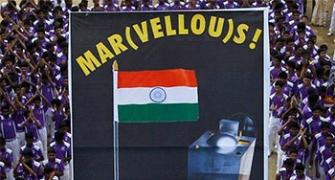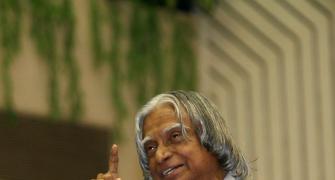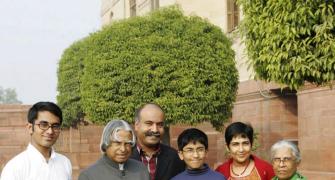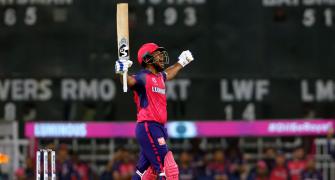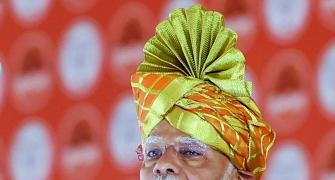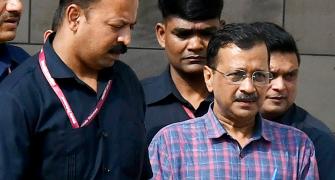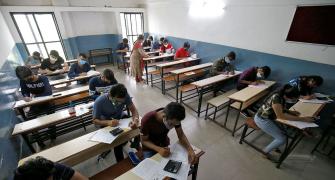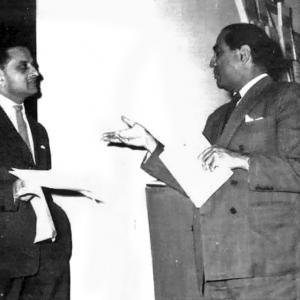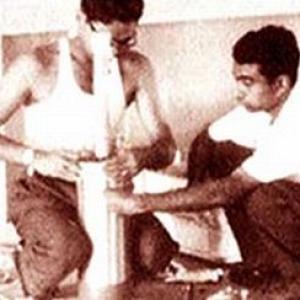'When a Project Director is appointed, the whole organization -- including the Chairman ISRO -- works for his success. It is a lesson that has been of abiding value all through the other projects I have worked on,' recalls the late President, one of the earliest pioneers at ISRO.

In 1962, Dr Vikram Sarabhai and Dr Homi Bhabha were looking for a site to establish the space research station in the equatorial region.
Thumba in Kerala was found most suitable as it was near the equatorial region and was ideally suited for ionospheric research.
The locality, however, was inhabited by thousands of fishermen living in the villages there.
It also had a beautiful church called St Mary Magdalene Church and the Bishop's house.
As such, the acquisition of the land did not move any further.
Dr Sarabhai met the Bishop, His Excellency Reverend Dr Peter Bernard Pereira, on a Saturday and requested transfer of the property. The Bishop smiled and asked him to meet him the next day.
In the Sunday morning service, the Bishop told the congregation, 'My children, I have a famous scientist with me who wants our church and the place I live for the work of space science and research. Science seeks truth that enriches human life.'
'The higher level of religion is spirituality. The spiritual preachers seek the help of the Almighty to bring peace to human minds.'
'In short, what Vikram is doing and what I am doing are the same -- both science and spirituality seek the Almighty's blessings for human prosperity in mind and body.'
'Children, can we give them God's abode for a scientific mission?'
There was silence for a while followed by a hearty 'Amen' from the congregation which made the whole church reverberate.
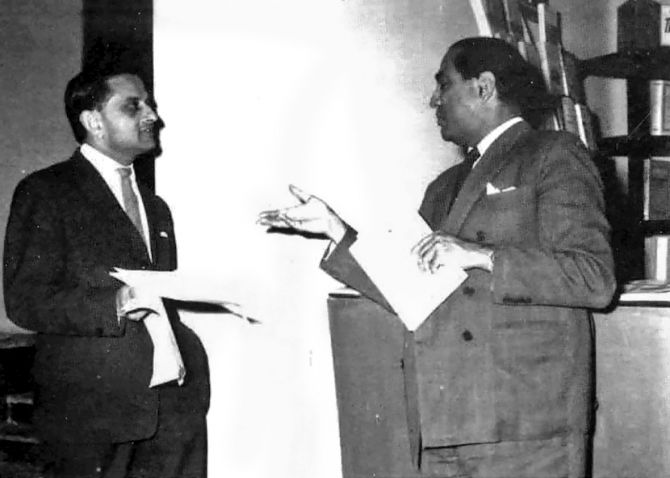
It was indeed a great experience working with Dr Sarabhai from 1963 to 1971. As a young engineer engaged in the tasks of composite technology, explosive systems and rocket engineering systems at the Thiruvananthapuram space centre I drew tremendous energy from his leadership.
Though the nation was in its technological infancy, Dr Sarabhai was dreaming of developing our own satellite launch vehicles.
These would be used to launch from Indian soil remote sensing satellites in sun-synchronous orbit and communication satellites in geosynchronous orbit.
Today, his vision is almost realized with the launch of the Geosynchronous Launch Vehicle (GSLV).
ISRO has also operationalized the IRS and INSAT systems, thereby bringing the benefits of space to the common man.
There is an experience I would like to share with you in relation to Dr Sarabhai's vision for space programmes.
The design project of India's first satellite launch vehicle (SLV-3) was taken up at the Vikram Sarabhai Space Centre (VSSC).
The design of each stage of rocket, heat shield and guidance system was given to selected project leaders.
I was given the design project of the fourth stage of SLV-3, that is, the upper stage rocket, which would give the final velocity to put Rohini into orbit.
This fourth stage uses an advanced composite material that provides high strength with minimum weight. It also has maximum loading of high energy solid propellant.
While we were developing the design of this upper stage in 1970, I received a call from Dr Sarabhai from Ahmedabad stating that he would be visiting Thiruvananthapuram along with Professor Hubert Curien, chairman of CNES, the French space agency.
I was asked to give a presentation about the fourth stage to Professor Curien's team.
When the presentation was over, we realized that the SLV-3 fourth stage was also being considered as upper stage for the French Diamont P-4 launch vehicle.
The CNES needed an apogee rocket motor nearly double the propellant weight and also size of the stage that we had designed.
A decision was then taken in the same meeting that the fourth stage should be reconfigured to match and suit both Diamont P-4 and SLV-3.
I mention this episode because at the time this decision was taken, we ourselves were in the design stage!

Such was Dr Sarabhai's confidence in the Indian scientific community. Development work on this stage started ahead of the other stages of SLV-3.
With our motivation thus boosted, work proceeded in full swing.
A series of reviews took place between the two teams and the fourth stage graduated from drawing board to developing stage.
Unfortunately in 1971, Dr Sarabhai passed away, and at the same time the French government called off the Diamont P-4 programme.
Once the fourth stage was developed and a series of tests was going on, a new requirement appeared on the horizon, in the form of India building a small communication satellite to be launched by the European Ariane launch vehicle.
For the APPLE -- Ariane Passenger Payload Experiment -- communication satellite, the SLV-3 fourth stage proved a perfect fit and it was included in the payload of the Ariane launch in 1981 from Kourou, French Guiana.
The vision seeded in 1970 by Dr Vikram Sarabhai was indeed realized when APPLE was placed in geostationary orbit and started communicating with our earth stations.
APPLE's success proved that a vision with committed scientific support will achieve its aim.
This achievement came as a fantastic fillip to the rocket technologists in the country.
The visionary may not be with us today but his vision gets realized.

The dream of Dr Sarabhai was shaped into reality by Professor Satish Dhawan.
After he took charge of ISRO from 1972, Professor Dhawan structured and nurtured ISRO with a space profile and his work led to many significant accomplishments and benefits from a number of remote sensing and communication satellites.
The Polar Satellite Launch Vehicle accomplished the feat of launching multiple satellites for India and other countries, injecting them in different orbits in a single mission.
I learned an important lesson in management from Professor Dhawan when I was appointed Project Director SLV-3 in 1972 to design, develop and launch the first satellite launch vehicle to inject Rohini into near earth orbit.
This was that when a Project Director is appointed, the whole organization -- including the Chairman ISRO -- works for his success.
It is a lesson that has been of abiding value all through the other projects I have worked on.
The other thing I have learnt after more than forty years of working in three departments in various projects and programmes is that you will succeed as a project leader as long as you remember that the project is bigger than you.
Wherever the project leader tries to make himself out to be bigger than the project, the enterprise suffers.
I recall my working at ISRO Headquarters, Bangalore, as Director, Launch Vehicle Programmes/ Systems, in the early 1980s, when we were debating the performance and cost-effectiveness of launch vehicles.
In 1981, the scientists of VSSC, Thiruvananthapuram, with the help of other ISRO centres, evolved a configuration of the PSLV core vehicle with two large strap-on boosters.
The PSLV weighed about 400 tonnes at take-off. Professor Dhawan wanted to study an alternative and simple configuration.
I and some of my colleagues, A Sivathanu Pillai, N Sundararajan and K Padmanabha Menon, carried out mission, technology and feasibility studies for the optimal configuration.
The team designed several options, including a unique core vehicle with an advanced solid propellant booster, using first stage rockets of SLV-3 as strap-ons.
This brought the PSLV weight down to only about 275 tonnes at take-off.

Professor Dhawan used to come almost daily to my small room, which was close to his office, and debate the possible configuration choice.
He was himself a foremost aerodynamic specialist with mathematics and system engineering background, and would illustrate his ideas on the blackboard and ask us to do more homework.
We also studied the growth opportunities of PSLV with cryogenic upper stage as a GSLV and the possibility of launching due-east geosynchronous missions.
Professor Dhawan put the two most favoured configurations up for discussion among the experts and the ISRO teams.
Detailed examination and debate, taking the long-term plans into account, took place and they chose the PSLV configuration as proposed by my launch vehicle team.
Professor Dhawan considered the future scenario of operationalization of PSLV and GSLV, bearing in mind the satellites and application programmes, and decided on this unique configuration and evolved the roadmap for ISRO for the next fifteen years.
I and Professor Narasimha brought out a book, Development in Fluid Mechanics and Space Technology, with Professor Dhawan's handwritten fifteen-year space profile, based on the chosen PSLV configuration.

A memorable day for me is 31 May 1982. Professor Dhawan gave me a send-off in an unconventional way.
He called an ISRO council meeting to discuss the future launch vehicle programme.
I made a presentation to the directors of the ISRO centres on performance and cost-effectiveness of our launch vehicles and the growth profile.
After the presentation, Professor Dhawan broke the news that he had given me to DRDO.
This decision indeed gave me a change that led to progress in a different field.
We see today self-reliance in launch vehicle technology with PSLV operational and GSLV getting ready to be operationalized.
This is close to the direction envisaged in the early 1980s by Professor Dhawan.
The recognition of ISRO as a successful organization was due to the strong foundation and space profile envisioned by him.
One test of leadership is also how well successors are able to carry forward a programme.
At ISRO, Professor U R Rao and Dr K Kasturirangan brought further success and glory to the organization.
After his retirement Professor Dhawan continued as a member of the Space Commission and in that capacity continued to help the organization which he built.
Remarkably, Professor Dhawan saw the space missions envisioned by him come into being in his lifetime.
He also saw in his lifetime many of those he had tutored emerge as strong technology leaders themselves who have contributed immeasurably to the country.
What a great personality he was!
Excerpted from Ignited Minds by the late President A P J Abdul Kalam, with the kind permission of the publishers, Penguin Random House India.

